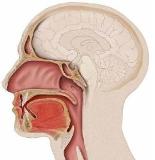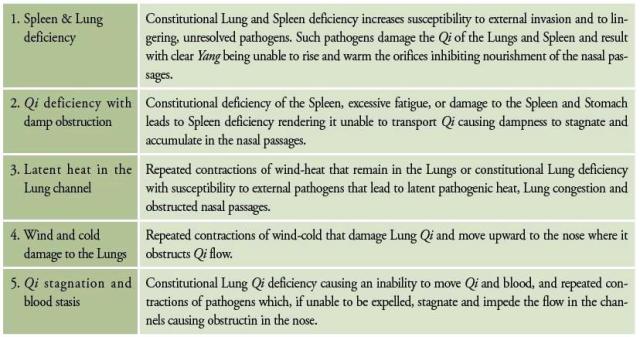SUN TEN Quarterly Newsletter Spring 2011: A Case Study on the TCM Treatment of Chronic Hypertrophic Rhinitis
A Case Study on the TCM Treatment of
Chronic Hypertrophic Rhinitis
By Dr. Zheng-cheng Yang
Chen Yue Qin TCM Clinic, Taiwan
Chronic hypertrophic rhinitis is an illness that affects many people and greatly impacts their lives. Severely obstructed nasal passages can lead to dizziness, heavy headedness, mental listlessness, fatigue, inability to concentrate, poor sleep and diminished memory. Those with post-nasal drip may develop cough (with phlegm).
In Traditional Chinese Medicine, rhinitis falls into the categories of nasal congestion 鼻窒 (bí zhì) or 鼻齆 (bí wèng). Within the Su Wen, the chapter Wu Chang Zheng Da Lun says: “During the time of Great Summer heat, there is coughing, sneezing, bleeding from the nose, and nasal obstruction.” It also says: “Lying on one side will open the upper nostril while the lower one will be obstructed.” In the chapter Xuan Ji Yuan Bing Shi, it says: “bí zhì means nasal obstruction lying on one side will open the upper nostril while the lower one will stay obstructed.” These passages describe the primary symptoms of this condition.

Clinical Presentation
This condition is most common in young men. It is neither seasonal nor regional in nature however; the symptoms tend to become more noticeable after the sufferer is exposed to cold or damp weather. Primary symptoms include continuous bilateral obstruction or obstruction that alternates between the nasal passages, nasal congestion that can be heard, and scant, thick nasal discharge. Patients who have these symptoms for extended periods with no resolution may develop a diminished sense of smell.
Rhinitis can usually be divided into two stages:
1. Thickening Phase: The mucous membrane appears dusky-red and becomes thickened, especially in the lower nasal concha, and its surface is flat and smooth. When pressure is applied with a probe, the mucous membrane shows edema-like pitting that doesn’t recover immediately, and there is diminished response to vaso-constricting pharmaceuticals.
2. Hyperplastic Phase: The mucous membrane appears grayish-white with an uneven surface. Mulberry-shaped protuberances can be seen at the fore-end of the nasal concha, which are hard to the touch. There is no edema-like pitting in the membrane, yet the response to vaso-constrictors is also diminished.

Key Points of Differentiation
Chronic hypertrophic rhinitis is often a development of chronic simple rhinitis. Simple rhinitis occurs intermittently and symptoms include alternating obstruction of the nasal passages, thickened secretions, a smooth glossy mucous membrane, and a positive response to vaso-constrictors. Nasal obstruction associated with chronic hypertrophic rhinitis is much more severe than in simple rhinitis and most commonly both nostrils are obstructed continuously. Symptoms common to both conditions are a diminished sense of smell and thickened nasal secretions. Symptoms such as a heavy head, headache, inability to concentrate, and snoring are also common.
From the TCM perspective, these two illnesses are most directly due to localized Qi and blood stasis.
Etiology & Pathomechanism
According to TCM, chronic hypertrophic rhinitis has five causative factors:

Join our member to get full-text article! Join Free!
[Clinical Case Study] for members only
[Patient’s Basic Information] for members only
[Chief Complaints] for members only
[The Four Examinations] for members only
[Diagnosis] for members only
[Treatment Principal] for members only
[Prescription] for members only
[Formula Analysis] for members only
[Second Visit] for members only
[Third Visit] for members only
[Follow-up Visits] for members only
[Conclusion] for members only
[Recommended Formulas used in the Chronic Hypertrophic Rhinitis Case Study] for members only